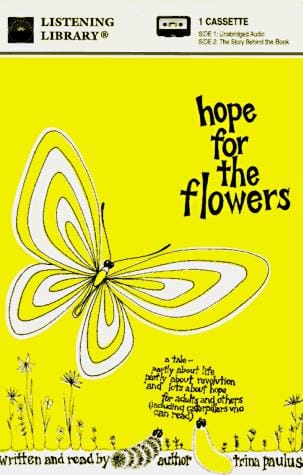Hope for the Flowers: Lessons on Transformation, Purpose, and Faith
An uplifting exploration of Hope for the Flowers, its storyline, symbolism, and the life lessons it offers about growth, purpose, and authentic success.

Introduction: A Little Book With a Big Message
There are books that entertain, books that inform, and then there are rare titles that quietly change the way you look at life. Trina Paulus’s classic "Hope for the Flowers" belongs to that third category. Published in 1972, the illustrated story of two caterpillars—Stripe and Yellow—has become an intergenerational favorite, read in classrooms, boardrooms, and living rooms across the globe. Its simple prose and whimsical drawings conceal a profound meditation on ambition, community, and the courage it takes to become who we are meant to be.
Book Snapshot
At fewer than 200 pages and rich with hand-drawn illustrations, the book can be enjoyed in a single sitting. Yet readers often return to it repeatedly, discovering fresh insights at every stage of life. Categorized as a children’s tale, "Hope for the Flowers" is better described as a parable—a brief story that uses everyday creatures to reveal universal truths. The caterpillar protagonists, the towering "caterpillar pillar," and the luminous butterflies each symbolize familiar human struggles and aspirations.
Plot Summary
The narrative begins with Stripe, a restless young caterpillar who wonders if life offers more than endlessly eating leaves. His curiosity leads him to a column of caterpillars climbing on top of one another, striving for a mysterious "something" at the top. Believing the summit must contain the meaning he seeks, Stripe joins the scramble upward. Meanwhile, he meets Yellow, another caterpillar who questions the purpose of the climb. Torn between affection for Yellow and his desire to reach the peak, Stripe abandons her to continue ascending. After witnessing the ruthless competition and the despair of those who fall, he finally reaches the pinnacle—only to discover nothing there but emptiness and wind. Haunted by disillusionment, Stripe descends and begins searching for Yellow. In the meantime, Yellow has discovered an alternative path: the slow, solitary process of building a cocoon. Though fearful, she trusts an inner voice urging her to let go. Eventually she emerges as a radiant butterfly and finds Stripe, encouraging him to undergo the same transformation. Their reunion in flight affirms that real fulfillment comes not from standing above others but from embracing one’s true nature.
Core Themes Worth Spreading
Authentic Purpose vs. External Success: The caterpillar pillar mirrors corporate ladders, social media follower counts, and any race where success is measured by comparison. Paulus reminds us that the summit is hollow if it requires trampling others or betraying ourselves.
Transformation Through Trust: Building a cocoon looks like withdrawal and even defeat, but it becomes the gateway to flight. Personal growth often requires seasons of stillness, study, or inner work that outsiders may misinterpret as stagnation.
Community and Compassion: While Stripe’s climb isolates him, Yellow’s journey toward metamorphosis ultimately unites the two in mutual uplift. Genuine community fosters growth that benefits all, rather than competition that benefits a few.
The Symbolism of the Caterpillar Pillar
Few images capture cutthroat ambition better than thousands of caterpillars stepping on each other in desperate ascent. Readers recognize the pillar in traffic jams, office politics, and even academic ranking. Paulus’s illustration forces us to ask: Is the top worth the collateral damage? The pillar crumbles when Stripe descends, suggesting that oppressive systems survive only when participants consent to the race.
Transformation, Faith, and Letting Go
Yellow’s cocoon phase is filled with uncertainty. She is not guaranteed the outcome, yet she surrenders to a process older than she is. In spiritual vocabulary, this is faith: acting on a hope not yet seen. For secular readers, it is a lesson in trusting the process—whether that means changing careers, starting therapy, or relocating to a new city. Growth rarely looks glamorous while it is happening, but the payoff can be breathtaking.
Why the Message Still Resonates Today
Half a century after publication, society continues to glorify speed, visibility, and hustle culture. Algorithms reward constant output; newsfeeds display highlight reels of seemingly perfect lives. "Hope for the Flowers" counters with an invitation to slow down and grow deep. Its emphasis on internal metamorphosis over external metrics feels startlingly modern amid burnout epidemics and Great Resignation headlines.
Lessons for Work, Education, and Relationships
Work: Climbing the corporate pillar without pausing to ask "Why?" can lead to disillusionment, even for those who reach executive height. The book challenges professionals to pursue roles that align with personal values.
Education: Students pushed to outcompete peers may memorize facts yet miss the joy of discovery. Educators can use Stripe and Yellow to illustrate that learning itself—not just grades—is the real prize.
Relationships: Stripe and Yellow show that supportive partnership fosters growth more sustainably than rivalry. Love rooted in respect becomes a safe cocoon where each person can transform.
How to Apply the Story’s Wisdom
1. Schedule regular "cocoon time"—quiet intervals for reflection, prayer, or journaling.
2. Redefine success in terms of contribution and contentment, not comparison.
3. Celebrate others who choose unconventional paths instead of competing with them.
4. Mentor or support someone earlier on the journey, becoming a wing to help them fly.
5. Re-read the book annually; each milestone in your life will highlight new layers of meaning.
Conclusion: Choose Wings Over Ladders
"Hope for the Flowers" endures because it names a longing we all share: to live a life that matters, free from the fear of falling behind. Stripe and Yellow show that true elevation begins the moment we stop scrambling and start trusting the quiet work within. In a world obsessed with upward mobility, Paulus’s gentle parable invites us to exchange ladders for wings—and in doing so, to discover hope not just for the flowers, but for ourselves.



